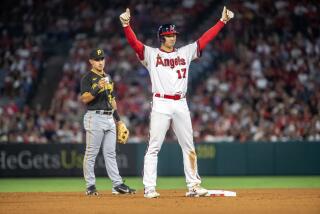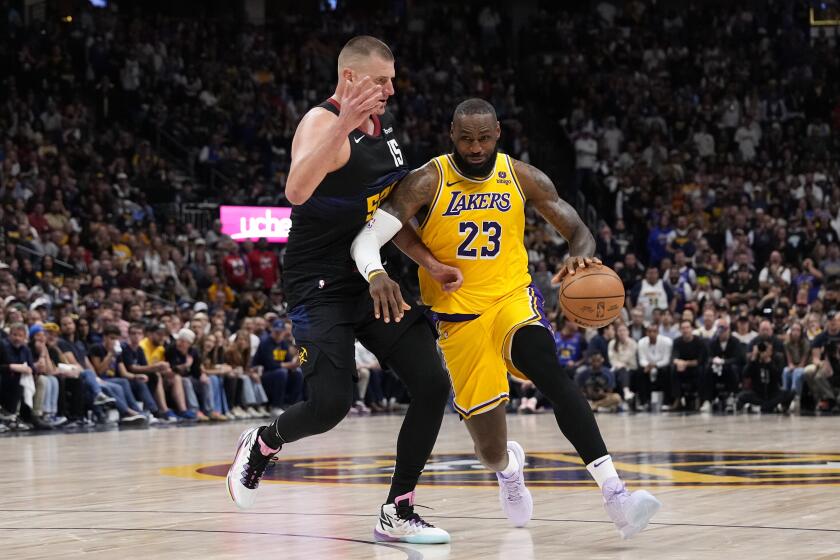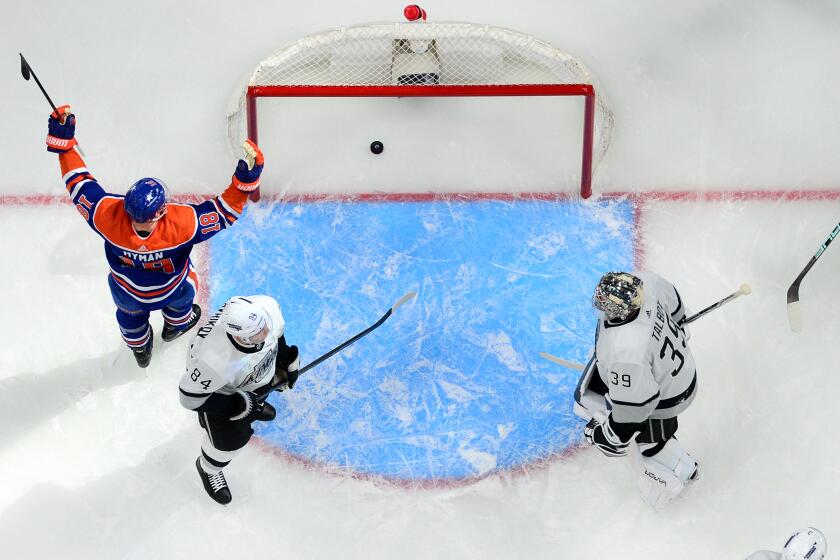Local trades: A look at the smash hits and flops
The young right-hander was prone to wildness and couldn’t crack the rotation of the pitching-rich New York Mets, who were seeking a steady third baseman after trying 45 players at the hot corner in 10 seasons. The Angels, though wary of the pitcher’s control problems, liked his arm and were willing to trade their six-time All-Star shortstop to get him.
And so on Dec. 10, 1971, the Angels made perhaps the best trade in their history by acquiring Nolan Ryan for Jim Fregosi.
“As for Ryan, I really can’t say I quit on him,” Bob Scheffing, then the Mets’ general manager, told the New York Times. “But we’ve had him three full years and, although he’s a hell of a prospect, he hasn’t done it for us. How long can you wait? I can’t rate him in the same category with Tom Seaver, Jerry Koosman or Gary Gentry.”
Fregosi broke his thumb at spring training in 1972 and batted .232 before he was traded to Texas. Ryan pitched four no-hitters in an Angels uniform, racking up 2,416 strikeouts in 2,1811/3 innings and recording 156 complete games over eight seasons.
The Angels let him leave as a free agent in 1979 after a dispute over incentive clauses and an insurance policy. General Manager Buzzie Bavasi, asked how he’d replace Ryan after a 16-14 season, uttered the immortal line, “You mean, where can I find two 8-7 pitchers?”
Ryan pitched for 14 more seasons and finished with a major league-record 5,714 strikeouts and seven no-hitters, earning a first-ballot ticket into the Hall of Fame.
Some of the greatest players in baseball, basketball and hockey have passed through Los Angeles via the trade route. Wayne Gretzky arrived in 1988 in a multiplayer deal with the Edmonton Oilers. Kareem Abdul-Jabbar came from Milwaukee in a six-player deal in 1975. Kobe Bryant became a Laker after the Charlotte Hornets chose him 13th in the 1996 draft and traded him to Los Angeles for Vlade Divac. The Times’ Mark Heisler, previewing that draft, envisioned Bryant would be chosen 19th by the New York Knicks. Heisler’s assessment: “Smaller than Kevin Garnett but has ability.”
Uh, yes.
Here is a look at the best and worst deals pulled off by the local baseball, NBA and NHL teams. For the Dodgers and Lakers, only deals made since they arrived in Los Angeles were considered.
Lakers
There have been several pivotal trades for the franchise, but some were prompted by player trade demands, as with Wilt Chamberlain and Abdul-Jabbar. However, the acquisition of Bryant was not only brilliant, but also opened many championship doors.
BEST, July 11, 1996: After technicalities were cleared up and Divac accepted a trade the Lakers had engineered with Charlotte before the draft, 17-year-old Bryant officially became a Laker. “We think this young man is really one of the most exciting young prospects we’ve seen in a long time,” said Jerry West, the Lakers’ executive vice president.
Five championships, 13 all-NBA team selections, four All-Star game most-valuable-player honors, two scoring titles, one regular-season MVP honor and 25 games in which Bryant has scored at least 50 points bear that out. Plus, the trade helped clear cap space for the Lakers to sign Shaquille O’Neal away from Orlando.
Other franchise changers:
July 9, 1968: Acquired MVP Chamberlain from Philadelphia for Jerry Chambers, Archie Clark and Darrall Imhoff. Chamberlain led the league in rebounding four times and was the MVP in the 1972 title run.
June 16, 1975: Acquired Abdul-Jabbar and reserve center Walt Wesley from Milwaukee for Elmore Smith, Brian Winters and rookies Dave Meyers and Junior Bridgeman. Abdul-Jabbar won five NBA titles and three MVP awards with the Lakers and held nine league records when he retired in 1989. He’s still the NBA’s all-time scoring leader.
Feb. 1, 2008: Acquired Pau Gasol and a second-round pick in 2010 for Kwame Brown, Javaris Crittenton, Aaron McKie, the draft rights to Marc Gasol, two first-round picks and cash. Gasol helped the Lakers to two championships.
WORST: There aren’t that many, which is why the Lakers have won 11 titles in Los Angeles. But on the theory that no acquisition of Benoit Benjamin can be considered a good one, we nominate sending Sam Perkins to Seattle on Feb. 22, 1993, for Benjamin and the rights to Doug Christie. Dikembe Mutombo, then with Denver, agreed.
“Sending Sam Perkins away hurt their cause,” he told The Times. “How do you send away someone who can play 40 minutes for someone who plays four minutes? I’m not trying to criticize, but for me I think it was one of the ugliest trades ever in this league.”
Benjamin averaged 4.5 points and 3.4 rebounds in 28 games and was traded to New Jersey in June 1993 for Sam Bowie and a second-round pick. Christie, coveted by the Lakers for his athleticism, never fit in during two seasons.
Clippers
It’s not trading that trips them up as much as poor drafting and the inability to keep players from leaving as free agents.
BEST: On draft day in 2001 they acquired Elton Brand, the No. 1 overall pick in 1999, for the rights to forward/center Tyson Chandler and forward Brian Skinner. “This trade brings us to another level sooner than we anticipated with the addition of Brand,” General Manager Elgin Baylor told The Times.
Brand blossomed into a premier power forward and the Clippers fended off Miami’s attempt to lure him away as a restricted free agent in 2003 by signing him for $82 million over six years. Brand led the Clippers to a first-round playoff victory over Denver in 2006, their first series win since 1976, but in 2008 he opted out of the final year of his contract — giving up $16.4 million — and signed with Philadelphia as a free agent.
WORST: Sending 1988 No. 1 pick Danny Manning to Atlanta for Dominique Wilkins and a first-round pick, on Feb. 24, 1994. Manning wanted out and both were about to become free agents. Wilkins averaged 29.1 points in 25 games with the Clippers but bolted for Boston as a free agent. The Clippers used that first-round pick to draft Greg Minor and traded him to Indiana the next day.
Wilkins told The Times in 1999 that he initially gave the Clippers the benefit of the doubt. “I thought, ‘Well, maybe it will change, maybe a new atmosphere will change it.’ Instead, it was a nightmare. It wasn’t professional at all. … I’d have to call it the worst time in my career.”
Dodgers
BEST TRADE: An oldie but goodie. They acquired left-hander Claude Osteen, infielder John Kennedy and cash from Washington on Dec. 4, 1964, for Frank Howard, Phil Ortega, Pete Richert and Dick Nen. Howard was a tremendous slugger and had great numbers, but Osteen was a perfect third starter and twice won 20 games. In two World Series he had an earned-run average of 0.86 and became the ace of the Dodgers’ staff after Sandy Koufax and Don Drysdale retired.
And he was traded in December 1973 for Jimmy Wynn, who helped the Dodgers win the 1974 National League pennant.
Other key moves:
• Acquiring reliever Mike Marshall from Montreal on Dec. 5, 1973, for outfielder Willie Davis. Marshall won the Cy Young Award in 1974, pitching in a record 106 games, as the Dodgers won the pennant. He was an All-Star in 1974 and 1975. Davis was enormously productive and popular but was nearing the end of his career.
• GM Ned Colletti’s acquisition of outfielder Andre Ethier from Oakland for troubled outfielder Milton Bradley and infielder Antonio Perez. Ethier made his first All-Star appearance last season and won the NL Silver Slugger award.
WORST: On Nov. 17, 1993, Fred Claire, the Dodgers’ executive vice president, traded pitcher Pedro Martinez to Montreal for second baseman Delino DeShields. He felt the move was necessary after free-agent second baseman Jody Reed surprisingly rejected Claire’s offer of a three-year, $6.6-million contract. Martinez went on to win the Cy Young Award three times and was an eight-time All-Star. De Shields hit .250, .256 and .224 in three seasons with the Dodgers and left as a free agent.
“We didn’t want to trade him, but we had a club with a very good chance to win and we were trying to get it to the next level,” Claire told The Times in 1998. “You could talk to 20 people and they would tell you that they thought we made a very good trade in acquiring a young All-Star with a tremendous upside. It didn’t work out, but no one is happier for Pedro’s success. He’s a great pitcher and person.”
For many fans the Dodgers’ recent downfall as a franchise began when Mike Piazza was traded to Florida on May 15, 1998. The deal was engineered by executives who took over when Rupert Murdoch’s News Corp. bought the Dodgers from the O’Malley family. Piazza had wanted a record contract and team President Bob Graziano refused, dealing Piazza and Todd Zeile for Gary Sheffield, Charles Johnson, Bobby Bonilla, Manuel Barrios and Jim Eisenreich. The players’ combined salaries of $109.3 million made it the most expensive trade in baseball history.
“They didn’t trade a player. They traded a franchise,” Times columnist Jim Murray wrote. “The Dodgers traded away more than a part of their team, they traded away part of their soul. If there’s a classic Dodger type, he was it. Almost a logo.”
Angels
BEST: Besides the trade for Ryan, the greatest in franchise history, the most prominent position player they acquired in a trade was first baseman Rod Carew, on Feb. 3, 1979. The Angels gave up outfielder Ken Landreaux, infielder Dave Engle and pitchers Paul Hartzell and Brad Havens for Carew, who batted above .300 in the first five of his seven seasons and helped the Angels reach the playoffs in 1979 and 1982 before being elected to the Hall of Fame.
WORST: An argument can be made that their trade of Jim Edmonds to St. Louis for Kent Bottenfield and Adam Kennedy was a net loss. Edmonds had a better career but Kennedy was a key figure in the Angels’ 2002 World Series win.
The jury is still out on the acquisition in January of outfielder Vernon Wells and the $86 million he’s owed over four years in exchange for Juan Rivera and catcher Mike Napoli.
Kings
BEST: The Kings stunned the hockey world on Aug. 9, 1988, by acquiring Gretzky from the defending Stanley Cup champion Edmonton Oilers, with bodyguard Marty McSorley and forward Mike Krushelnyski, for Jimmy Carson, Martin Gelinas, two first-round picks and about $15 million. His star power attracted celebrities who had never been closer to ice than the cubes in their drinks and he triggered a youth hockey boom that continues to produce talent and send local kids to college, junior leagues and the NHL.
He became the NHL’s all-time leading scorer while with the Kings, won three scoring titles and was the league’s MVP in 1989. He holds their playoff record for assists (65) and points (94), though the closest he got them to the Cup was a five-game loss in the 1993 finals, their lone finals appearance.
WORST: So, so many. But the worst has to be GM Sam McMaster trading Gretzky — who wanted out after the team declined and new owners AEG didn’t want to invest in better talent — to St. Louis for Craig Johnson, Patrice Tardif, Roman Vopat and two draft picks on Feb. 27, 1996. McMaster should have held out for more, because Blues GM Mike Keenan had openly spoken of how much he wanted Gretzky and McMaster could have threatened him with tampering charges. None of the players the Kings acquired had any impact.
In their early days the Kings often traded first-round draft picks for veterans, a practice favored by original owner Jack Kent Cooke. Other teams used the Kings’ top picks to select Steve Shutt, a Hall of Fame left wing; Ray Bourque, a Hall of Fame defenseman; Phil Housley, a longtime defensive standout, and Tom Barrasso, a standout goaltender.
Ducks
BEST: The Ducks acquired Jean-Sebastien Giguere from Calgary on June 10, 2000, for a second-round pick in the 2000 draft, a move made possible because the Flames couldn’t protect him in the expansion draft that stocked the new Columbus Blue Jackets and Minnesota Wild. Giguere led the Ducks to the Stanley Cup finals in 2003 with a 1.62 goals-against average and .945 save percentage and was voted the MVP of the playoffs despite the Ducks’ seven-game loss to New Jersey. In 2007, with a more potent team around him, he posted a 1.97 goals-against average and .922 save percentage as the Ducks won the Cup with a five-game finals victory over Ottawa.
A couple of other moves also were tied to their championship:
• GM Brian Burke acquired defenseman Chris Pronger from Edmonton for right wing Joffrey Lupul, defenseman Ladislav Smid and two draft picks on July 3, 2006. Pronger made them a dominant force and was crucial to their Cup run.
• On March 11, 2003, GM Bryan Murray acquired Rob Niedermayer from Calgary for goalie J.F. Damphousse and defenseman Mike Commodore. Niedermayer was a standout in both Cup runs and his presence led his Norris trophy-winning brother, Scott, to sign with the Ducks as a free agent in August 2005 and help transform them into a championship team.
Also worth mentioning is the Feb. 7, 1996 acquisition of right wing Teemu Selanne, the rights to Marc Chouinard and a draft pick from Winnipeg for center Chad Kilger, defenseman Oleg Tverdovsky and a draft pick. Without a doubt a one-sided trade, and so began Selanne’s still-strong attachment to Anaheim.
WORST: Scott Niedermayer took a sabbatical after the Cup victory and his decision to return put the Ducks in a salary-cap bind. To clear space Burke traded center Andy McDonald — who had a $3.33-million salary — to St. Louis on Dec. 14, 2007, for veteran center Doug Weight, left wing Michal Birner, and a late draft pick. Weight didn’t like the trade and played like it, collecting six goals and 14 points in 38 games. He left for the New York Islanders as a free agent in July 2008. Birner never played in the NHL. McDonald has been productive with the Blues and scored 20 or more goals each of the last two seasons.
twitter.com/helenenothelen
More to Read
Get our high school sports newsletter
Prep Rally is devoted to the SoCal high school sports experience, bringing you scores, stories and a behind-the-scenes look at what makes prep sports so popular.
You may occasionally receive promotional content from the Los Angeles Times.







